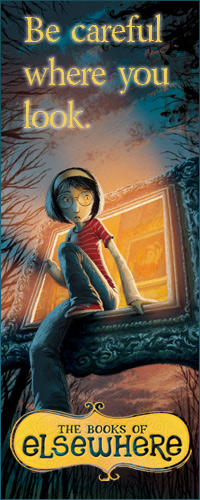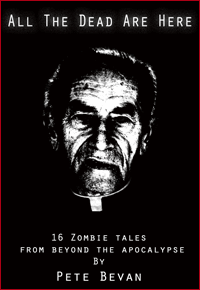ZOMBIE HAIKU by Joshua Gage
December 9, 2009 Poetry Tags: poem
calliope whine
the clown’s greasepaint
smeared with blood
scabrous eyelids
the tips of her finger bones
beneath cracked nails
shoulder bitten
the burnt taste
of the rifle barrel











A tryptic haiku. nice.
Comment by Pete Bevan on December 9, 2009 @ 1:36 pm
That’s not a haiku
It should be five-seven-five
Like what I just wrote.
Comment by Grammar Zombie. on December 9, 2009 @ 9:57 pm
@Grammar
Haiku in English
can really do whatever
the writer fucking wants.
(For real. There are plenty of Haiku writers in English and other languages that use varying numbers of syllables in addition to dropping the usage of season words and kireji. I know it’s the internet and all, but on a writing site please know what you’re talking about before posting something like that. Because if you want to be a real bitch about it, no haiku in English are actually haiku, including your rather poor one.)
Comment by admin on December 9, 2009 @ 11:29 pm
Wow, I wasn’t being malicious. (A tad snarky, I’ll allow.) I stand corrected. Humblest apologies. It feels a little like you brought a gun to a spitball fight there, though.
Comment by Grammar Zombie on December 10, 2009 @ 3:56 pm
No worries, mate. Just a pet peeve when people ‘correct’ someone with an incorrect correction.
Comment by admin on December 10, 2009 @ 4:14 pm
I tried to write a haiku in response but after half an hour I’ve realised I can’t write Haiku at all.
Comment by Pete Bevan on December 11, 2009 @ 2:33 am
Flesh tears off the skin
Black birds circle overhead
Waiting for the feast
Comment by Sleinte O'Donnell on December 11, 2009 @ 2:15 pm
From the Haiku Society of America:
Notes: Most haiku in English consist of three unrhymed lines of seventeen or fewer syllables, with the middle line longest, though today’s poets use a variety of line lengths and arrangements. In Japanese a typical haiku has seventeen “sounds” (on) arranged five, seven, and five. (Some translators of Japanese poetry have noted that about twelve syllables in English approximates the duration of seventeen Japanese on.) Traditional Japanese haiku include a “season word” (kigo), a word or phrase that helps identify the season of the experience recorded in the poem, and a “cutting word” (kireji), a sort of spoken punctuation that marks a pause or gives emphasis to one part of the poem. In English, season words are sometimes omitted, but the original focus on experience captured in clear images continues. The most common technique is juxtaposing two images or ideas (Japanese rensô). Punctuation, space, a line-break, or a grammatical break may substitute for a cutting word. Most haiku have no titles, and metaphors and similes are commonly avoided. (Haiku do sometimes have brief prefatory notes, usually specifying the setting or similar facts; metaphors and similes in the simple sense of these terms do sometimes occur, but not frequently. A discussion of what might be called “deep metaphor” or symbolism in haiku is beyond the range of a definition. Various kinds of “pseudohaiku” have also arisen in recent years; see the Notes to “senryu”, below, for a brief discussion.)
SENRYU
Definition: A senryu is a poem, structurally similar to haiku, that highlights the foibles of human nature, usually in a humorous or satiric way.
Notes: A senryu may or may not contain a season word or a grammatical break. Some Japanese senryu seem more like aphorisms, and some modern senryu in both Japanese and English avoid humor, becoming more like serious short poems in haiku form. There are also “borderline haiku/senryu”, which may seem like one or the other, depending on how the reader interprets them.
Many so-called “haiku” in English are really senryu. Others, such as “Spam-ku” and “headline haiku”, seem like recent additions to an old Japanese category, zappai, miscellaneous amusements in doggerel verse (usually written in 5-7-5) with little or no literary value. Some call the products of these recent fads “pseudohaiku” to make clear that they are not haiku at all.
Comment by Joshua Gage on December 14, 2009 @ 7:50 am
nice ones, Josh. especially like the first one… good image.
Comment by Greg Schwartz on December 16, 2009 @ 1:34 pm
冬ã¨ä¼šã†ã€‚
炬燵ã¨ã¿ã‹ã‚“。
å¤ã¯ã©ã“?
Comment by Citizen Zombie on December 21, 2009 @ 5:42 am
Haikus are fun
but sometimes dont make sense,
Refridgerator
Comment by mmpat on January 5, 2010 @ 4:25 am
Since I’m buddies with a haiku poet who reads Japanese I’ve been in on the fact that it’s not 17 syllables in English for a good long time. What a freeing discovery that was.
Comment by Charles Gramlich on January 5, 2010 @ 3:29 pm
Zombies are now here
Remember the brave that fought,
Remember Yonkers!
Comment by Nathan on January 14, 2010 @ 9:06 pm
Past all the grammer issues, this was a good poem, i liked it!
Comment by ChaosPeng on December 9, 2010 @ 8:23 am